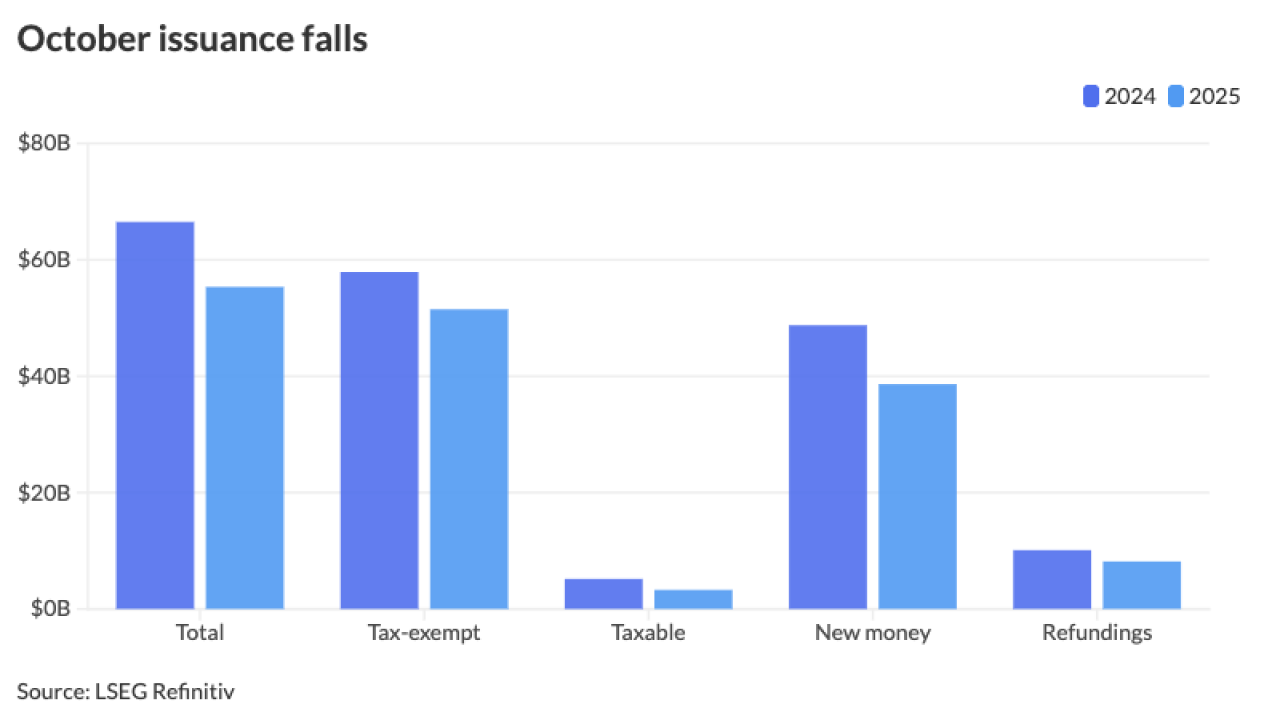
SAN FRANCISCO — Even as the market for qualified school construction bonds is taking off, many California school districts appear to be stuck on the sideline because of questions over the way the state allocated QSCB authority to the districts.
The QSCB program, authorized as part of the federal stimulus legislation earlier this year, allows school districts to issue bonds that provide bondholders with a 100% tax credit.
The legislation set a nationwide QSCB allocation of $11 billion for 2009 and $11 billion for 2010, with the federal government directly allocating 40% of the total to 100 large school districts.
The remaining funds were divided among state governments to allocate among their school districts. And that’s where the rub appears to be in California.
The state Department of Education allocated $700 million in QSCB authority. It received 231 applications for more than $3.7 billion in QSCB allocation. The DOE held a lottery in August, and 43 districts were awarded allocations.
They have a Dec. 31 deadline to issue the bonds, but so far not a single state-allocated QSCB has been issued in California.
According to several market participants, that’s because bond and disclosure counsel have been uncomfortable signing off on the deals over concerns about the way the allocation process was structured.
“Clearly our clients are very eager to have that problem resolved and I think we are all a little surprised at these last-minute potential delays,” said Dale Scott of San Francisco financial advisory firm Dale Scott & Co.
“I’m sure that the state DOE will figure out a way to make everybody satisfied and comfortable rendering their opinions,” he said.
Financial adviser Jeffrey Small, managing director at Capitol Public Finance Group LLC in Sacramento, said one client that won the QSCB lottery, the Chawanakee Unified School District, will be unable to take advantage of its $8 million allocation.
“We were unable to sell the QSCB, because we were unable to get a valid legal opinion that the delivery of the QSCB [allocation] was done properly,” Small said.
Facing deadlines with construction contractors, the district and its advisers switched gears, and plan to price the certificates of participation Monday as taxable direct-pay Build America Bonds — still at substantial savings compared to a traditional tax-exempt financing, but much less than the QSCBs would have provided.
The district is planning to price $12 million of COPs next week, including $10.1 million of BABs. Southwest Securities Inc. is the underwriter.
“I’m estimating that if they could have done a QSCB, they could have saved, on a net-present value, $3 million,” Small said.
Would-be California issuers appear to be stalled even as the market for the tax-credit bonds appears to finally be taking off. Total QSCB issuance through Wednesday is $1.321 billion in 104 issues, according to Thomson Reuters.
At first there was only one buyer for the credits, according to Russell Goings, managing director at Cabrera Capital Markets LLC in Los Angeles.
“It looks like investors are getting into the market,” he said. “Now there’s several other buyers in the marketplace so things are looking different.”
Small said Chawanakee USD had a market if it had been able to issue QSCBs; he had located an investor who was willing to buy the bonds at a supplemental coupon in the 2% range.
But the district couldn’t proceed due to the potential legal cloud.
“We just don’t want to be in a situation where we’ve committed the district to issuing bonds and then feeling an investor didn’t get what they bargained for when they bought the bonds,” Small said.
He said attorneys appear concerned that the Education Department lacked clear authority in state law to conduct the allocation. The lawyers would prefer legislation explicitly authorizing the department to make allocations.
“I would not expect you to see any QSCBs issued until that issue gets straightened out,” Small said.
Bond attorneys contacted for this story declined to comment.
The West Contra Costa Unified School District had put a $25 million QSCB deal on the calendar this week, underwritten by Piper Jaffray & Co. with KNN Public Finance as financial adviser, but it was moved to the day-to-day status Tuesday, according to Thomson Municipal Market Monitor.
The California Department of Education did not return phone calls this week on the topic.
This year’s allocations expire on Dec. 31, but the DOE, according to its Web site, has a provision for extensions on a case-by-case basis.
Small believes the problem will be solved.
Another client, the Sanger Unified School District in Fresno County, is moving forward with plans to issue its $25 million allocation.
“We all have an incentive to make it work,” he said. “I’m confident.”
There have been three QSCB deals done in California — all by districts with a direct federal allocation. They include the first offering, by the San Diego Unified School District in April, and the largest, a $318.8 million Oct. 1 issue from the Los Angeles Unified School District.
Underwriter Goldman Sachs, in press material, said the LAUSD transaction was the first with multiple buyers, which included insurance companies, investment managers, banks and hedge funds. The bonds pay a 1.54% interest rate, plus the tax credit.
California also allocated $73.5 million for charter schools, to be allocated through a separate process through the state treasurer’s office and its California School Finance Authority.
The CSFA received 28 applications for about $200 million in authority.
In October, the authority approved six of those applications, for $29 million, saying they were the only ones to meet its minimum credit criteria.
The CSFA is encouraging the remaining would-be borrowers to rework their applications, with plans to approve qualifying applications on a first-come, first-served basis
The authority, which will serve as conduit issuer for the charter schools, wants to close the deals by the end of March.





